- EUR/JPY gains momentum to near 163.00 in Monday’s early Asian session, up 33% on the day.
- The lack of clear guidance on the next BoJ rate hike timing weighs on the JPY.
- ECB’s Cipollone said the central bank should cut rates further to support recovery.
The EUR/JPY cross attracts some buyers to around 163.00 during the early European session on Monday. The Japanese Yen (JPY) weakens against the Euro (EUR) amid the uncertainty over the Bank of Japan’s (BoJ) rate-hike plans. The European Central Bank (ECB) Vice President Luis de Guindos and Phillip Lane are scheduled to speak on Monday.
The BoJ Kazuo Ueda said this Monday that the timing for when the central bank adjusts the degree of our monetary support will depend on the economic, price, and financial outlook. Ueda further stated that the Japanese central bank wouldn’t necessarily wait for external risks to completely fade before hiking again. Nonetheless, he offered few clues on whether the BoJ would raise rates in December. The lack of clear guidance on the next rate hike timing exerts some selling pressure on the JPY and creates a tailwind for EUR/JPY.
The verbal intervention from the Japanese authorities could provide some support to the JPY and cap the upside for the cross. Japan’s Finance Minister Katsunobu Kato said on Friday that the Japanese government will scrutinize the Foreign exchange market with very high vigilance and take appropriate action against excessive moves.
On the Euro front, the European Central Bank (ECB) board member Piero Cipollone noted on Friday that the ECB should cut interest rates further to support a nascent economic recovery in the Eurozone and also in the face of potential new trade tariffs in the US. However, the pace and extent of rate cuts will depend on the incoming data. The dovish comment from the ECB policymakers could undermine the Euro in the near term.
Bank of Japan FAQs
The Bank of Japan (BoJ) is the Japanese central bank, which sets monetary policy in the country. Its mandate is to issue banknotes and carry out currency and monetary control to ensure price stability, which means an inflation target of around 2%.
The Bank of Japan embarked in an ultra-loose monetary policy in 2013 in order to stimulate the economy and fuel inflation amid a low-inflationary environment. The bank’s policy is based on Quantitative and Qualitative Easing (QQE), or printing notes to buy assets such as government or corporate bonds to provide liquidity. In 2016, the bank doubled down on its strategy and further loosened policy by first introducing negative interest rates and then directly controlling the yield of its 10-year government bonds. In March 2024, the BoJ lifted interest rates, effectively retreating from the ultra-loose monetary policy stance.
The Bank’s massive stimulus caused the Yen to depreciate against its main currency peers. This process exacerbated in 2022 and 2023 due to an increasing policy divergence between the Bank of Japan and other main central banks, which opted to increase interest rates sharply to fight decades-high levels of inflation. The BoJ’s policy led to a widening differential with other currencies, dragging down the value of the Yen. This trend partly reversed in 2024, when the BoJ decided to abandon its ultra-loose policy stance.
A weaker Yen and the spike in global energy prices led to an increase in Japanese inflation, which exceeded the BoJ’s 2% target. The prospect of rising salaries in the country – a key element fuelling inflation – also contributed to the move.
Read the full article here

